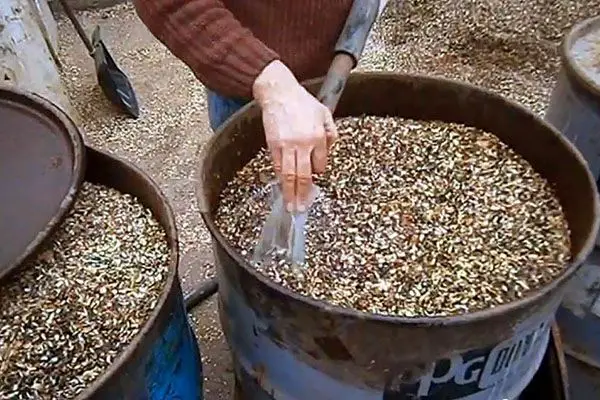If the substrate is not thermally treated (sterilized or pasteurized), many competitive microorganisms or contaminants appear on it. These are mainly various mold fungi from the genera Trichoderma, Penicillium, Mycog, Sclerotium, or higher weed dung fungi of the genus Coprinus. The control of competitive microflora is possible not only by heat treatment methods but also by the use of a number of chemicals. Must look at different guides in the Mushroom Knowledge section.

Table of Contents
Chemical Sterilization of Mushroom Substrate
Consider some examples of chemical processing.
Processing quicklime
Quicklime (CaO) is a very alkaline preparation, it dissolves in water (is quenched), forming slaked lime Ca(OH)2.
When straw is immersed in a bath with Ca(OH) 2 solution, all microflora in the vegetative stage is inactivated. The processing is very simple. The solution of lime should be in the range of 0.5-1.0%, the pH of the solution is 9.5-10.0. The straw is infused in this alkaline solution overnight.
Then the solution is drained. However, we must remember that it is toxic to plants. Straw after draining the solution has a pH of 8.5. Oyster mushroom mycelium is much more resistant to an alkaline environments than competitive organisms (Trichoderma). After 3-4 days of incubation, the pH gradually decreases, as oyster mushroom mycelium releases organic acids during growth. 1 week after inoculation, the straw is completely colonized by mycelium. If the straw is too alkaline, you can do another rinse with water.
Must look at Sterilize mushroom Substrate with Autoclave.
Treatment with sodium hypochlorite
The straw is immersed in a 5% sodium hypochlorite solution. Processing time is not less than 4 hours and not more than 12 hours. After draining the solution and bringing the straw to the desired moisture content (drying), inoculation is carried out. It is known that sodium hypochlorite works better in an alkaline environment, so it is possible to improve processing by adding some amount of lime to pH ~ 8-8.5.
Detergent treatment
Various types of detergents are used. The straw is immersed in a detergent solution and washed from the surface from mineral and organic contaminants. The effect of the detergent is twofold:
- Straw surface is prepared for enzymatic hydrolysis;
- Fouling and infectious spores are washed away.
After treatment with detergents (washing powder is one of the options), the substrate should be washed well with excess water.
Fungicide treatment
Oyster mushroom mycelium in certain concentrations of fungicides shows resistance to them or tolerance, while the growth of competitive mold mycelium completely stops. Due to this feature, it is possible to use fungicides to control competitive molds.
- Carboxin – the substrate is soaked for 18 hours in a solution containing 5 ppm of the drug. Carboxin delays the formation of sporophores (primordia or rudiments) of oyster mushroom for 2-3 days, but does not negatively affect the yield.
- Carbendazim. The substrate is immersed in a solution containing 25 ppm of the drug for 16 hours.
- Benomyl (foundazol, benlat). The substrate is soaked in a solution containing 25-50 ppm of the drug for 16 hours.
All of these drugs are poorly soluble in water, and for their uniform distribution in the substrate, it is necessary to first suspend the drugs in a large volume of water. In some cases, a specially water-soluble form of the drug is produced. For example, benomyl after reaction with cyclodextrins (cyclic forms of starch) becomes water-soluble and its efficiency increases by almost an order of magnitude (5-10 times).
Treatment with formalin or formaldehyde
The substrate is soaked in a solution containing 500-800 ppm of formaldehyde for 16 hours. After treatment, the substrate is deactivated with an alkali solution of NaOH or Ca(OH) 2 or hot air to drive off formaldehyde vapors.
Treatment with liquid ammonia
The substrate is soaked in a solution containing 1000 ppm ammonia (NH4OH) for 18 hours. Then the substrate is neutralized with an acid solution (acetic, citric, hydrochloric) or treated with hot air to drive off ammonia vapors.
Fumigation with ethyl formate
If a well-insulated chamber is available, the substrate can be fumigated with ethyl formate for 24 hours. The concentration of the drug is 600 mg / l of air. This fumigant itself is non-toxic and after reaction with water (when the substrate is soaked), it hydrolyzes to form ethyl alcohol and formic acid.
Other options for the use of chemicals are also possible. Often do the joint use of drugs, such as formaldehyde and carbendazim. A comparative analysis of the use of various drugs is given in Table.
Comparative analysis of various chemical processing methods
| Treatment | Conditions | Remains | |
|---|---|---|---|
| Carboxin | Soaking 18 hours in solution 5 ppm | Requires no special equipment | No |
| Ethylformat | Fumigation 24 hours 600 mg/l, then hot air 60 ° 4-5 hours | Fumigation chamber with good insulation | No |
| liquid ammonium | Soaking in a solution of 1000 ppm, then treatment with phosphoric acid (a) or hot air (b) | labor-intensive | No |
| Formaldehyde | Soaking in 800 ppm solution, then hot air treatment | labor-intensive | No |
| Hot water | Soaking at 60° 10 minutes | Not required | No |
conclusion
In conclusion, it should be said that in practice more reliable results are obtained by combining heat treatment with the use of chemicals (fungicides, lime, etc.).
